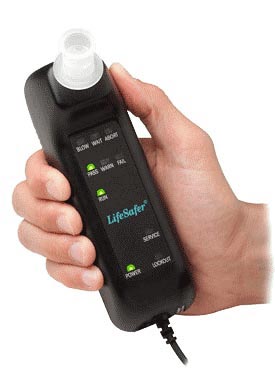 You may have gotten a brief introduction to Ignition Interlock Devices in your drivers education course, but you may not have gotten many details about them. Curious about how they work? Read on to find out exactly what they’re used for and when.
You may have gotten a brief introduction to Ignition Interlock Devices in your drivers education course, but you may not have gotten many details about them. Curious about how they work? Read on to find out exactly what they’re used for and when.
What is an Ignition Interlock Device?
An Ignition Interlock Device (IID) is a device (usually installed on a vehicle’s dashboard) that is used to measure a driver’s blood alcohol content (BAC) before they begin driving. Typically, it is mandatory that a driver have one installed after they are convicted of a DUI/DWI. The driver must blow into the IID before they begin driving in order to ensure that they are sober enough to operate a motor vehicle. In some states, IIDs are a requirement for all convicted drunk drivers; many other states are looking at legislation that will do the same.
When Will I Be Required to Have an IID Installed?
This varies by state, but generally you will be ordered to install an ignition interlock device under the following circumstances:
- You are convicted of a DUI/DWI for the first time with a BAC over a specified level
- You are a repeat DUI/DWI offender
- You refuse to provide a breath/blood sample for a chemical test when asked by a law enforcement officer
What Happens If My BAC Is Too High?
If your BAC result is higher than the level programmed into the IID, the vehicle will be unable to start. This way, if a driver is deemed unfit to drive, they will be prevented from endangering other motorists and pedestrians.
Even if you do pass the BAC test, you may be subject to random retests during your drive. This is to ensure you do not drink (or drink more) after passing the initial test. The IID may require you to give breath samples at certain points, in order to log the results. If your BAC is over the limit during a retest, the IID will not turn off your engine, but it will signal you to stop driving. Some devices will engage your horn and emergency flashers if your BAC is too high while driving; the only way to turn them off is to turn off your vehicle.
All results from your breath samples will be reported to the court (or whoever ordered you to have the IID installed). There are two possible ways your sample information can be reported:
- Immediately (through wireless technology)
- Once a month
When the data gets reported depends on your state’s requirements.
How Will an IID Affect Me?
Many drivers mistakenly believe that an ignition interlock device will only be installed in one of their vehicles; in reality, an IID will be installed in each vehicle the offender owns. You will only be allowed to drive vehicles that are equipped with IIDs during the period set by the court.
You may choose not to drive (which will mean relying on public transportation or rides from others), but you will still be required to comply with an IID. When you have your driving privileges reinstated, the IID period will begin the day you are issued a license.
How Long Will I Have an IID?
This will depend on various factors, including the offense you were convicted of, the state you reside in, and the number of times you have committed the offense. The length of time that you can have an IID in your vehicle could range from 3 months to 2 years or more. Again, it all depends on your individual situation.
What Happens If I Try to Disconnect or Remove the IID?
Many devices will cause your car’s emergency flashers to turn on, and your horn to go off, if you try to take out the IID. The incident will be logged (the way your breath results are reported), and a service reminder will be sent out, so that your IID can be fixed/replaced.
In addition, you could face fines, jail time, and an extension of the IID period; the exact consequences depend on the circumstances.
As you can see, ignition interlock devices are a strict response to a DUI conviction. Always avoid drinking and driving so that you don’t end up having to install one!










